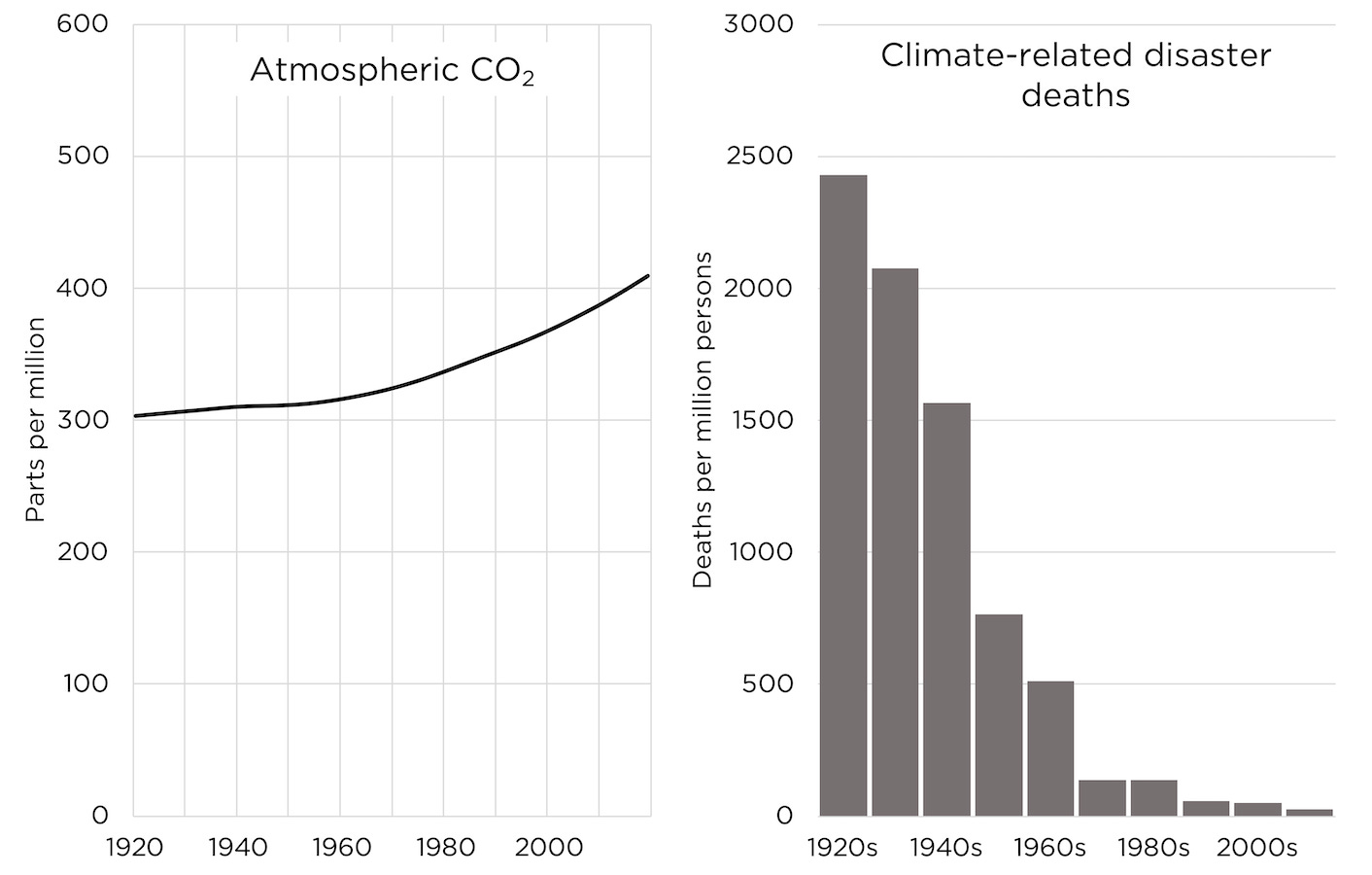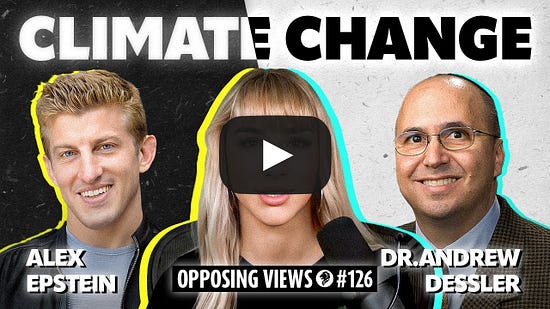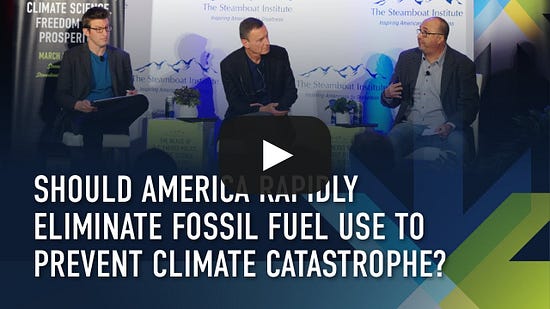Begin forwarded message:
From: "Alex Epstein, Energy Talking Points" <alexepstein@substack.com>
Date: August 15, 2022 at 12:03:19 PM CDT
To: bobbygmartin1938@gmail.com
Subject: 20 myths about fossil fuels, refuted
Reply-To: "Alex Epstein, Energy Talking Points" <reply+14p8nd&1kn62y&&bee247ad4268096b4d7eb4c498f0b25561b6d3188c390dd936196c6b5d29c277@mg1.substack.com>
20 myths about fossil fuels, refuted
Open in browser 20 myths about fossil fuels, refuted
In Fossil Future I refute literally hundreds of myths about fossil fuels. Here are 20 myths that 11,000,000 people heard on Joe Rogan's podcast this year.
In my book Fossil Future, I refute literally hundreds of myths about fossil fuels.
Here are 20 myths that 11,000,000 people heard on Joe Rogan's podcast this year from Andrew Dessler, a climate scientist/activist who misrepresented himself as an energy expert.Tonight Andrew Dessler will be debating physicist Steve Koonin, author of Unsettled, whom Dessler unconscionably smeared on Joe Rogan as akin to a tobacco lobbyist. The debate will be live in NYC and streamed. Order your tickets here.
Myth 1: We can rapidly reduce fossil fuels at very low cost.
Truth: Fossil fuels are a uniquely cost-effective form of energy, which is why they are 80% of global energy and still growing. Rapidly reducing fossil fuels, in a world that needs far more energy, is catastrophic.¹
Myth 2: Solar and wind are cheap.
Truth: Solar and wind are unreliable, parasitical sources of energy that add costs to the grid.
Claims of "cheapness" are based on ignoring the full costs of solar + wind—above all the cost of a reliable grid that gives them 24/7 life support.²
Myth 3: Solar/wind is cheaper than fossil fuels because Lazard's "Levelized Cost of Electricity" (LCOE) is lower for solar/wind.
Truth: LCOE, by Lazard's own admission, doesn't include many costs of solar/wind—above all the cost of a reliable grid needed for 24/7 life support.³
Myth 4: Solar and wind are "winning in the marketplace," outcompeting fossil fuels and nuclear with superior economics.
Truth: Unreliable, parasitical solar and wind are only "winning" when given massive preferences—mandates, subsidies, and no penalty for unreliability.⁴
Myth 5: Renewable energy is projected to exceed fossil fuel energy by 2026.
Truth: This projection is of electricity (20% of energy) not all energy—and just refers to when sunlight and wind are at their peak, not most of the time. And it depends on massive political favoritism.⁵Myth 6: We can have a grid with 75% solar and wind, with just 25% of hydro, geothermal, or nuclear.
Truth: No one has come close to even 50% unreliable solar/wind without huge dependence on reliable neighbors. And without the flexibility and scale that only natural gas provides.⁶
Myth 7: Anti-fossil fuel activists just want the most energy for the least CO2.
Truth: Anti-fossil-fuel activists are hostile to hydro and nuclear. E.g., Andrew Dessler said this year "I agree that hydro is not something to expand" and has attacked nuclear for years.⁷
Myth 8: Nuclear is too expensive, so we should use solar/wind instead.
Truth: Solar/wind can't provide reliable energy; nuclear can. And nuclear is only expensive because it has, with the help of many "green" activists, been falsely labeled unsafe and effectively criminalized.⁸Myth 9: Academics know how to cheaply power the world with mostly solar + wind.
Truth: All their untested schemes involve many ruinous, unaccounted-for costs—e.g., a crash program of unprecedented mineral/infrastructure development in an anti-development political environment.⁹The academics who have supported fossil fuel restrictions based on the false promise that their untested schemes full of false assumptions could replace fossil fuels in a world that needs far more energy, are irresponsible cranks who have brought about a global energy crisis.¹⁰
Myth 10: The TX winter blackouts were a failure of fossil fuels, especially natural gas.
Truth: Fossil fuels perform beautifully in far worse winter weather than Texas had in February 2021. TX blackouts were caused by defunding reliable/resilient power in favor of unreliable solar/wind.¹¹Myth 11: Hugely varying estimates of "the social cost of carbon" mean that economists warning about the costs of reducing CO2 can't be trusted.
Truth: These variations show that little definite is known about any net harm from CO2. But the huge harms of reducing CO2 are certain.¹²
Myth 12: Replacing fossil fuels with solar/wind will make us more secure because we'll depend less on hostile countries.
Truth: Not only are solar/wind incapable of replacing fossil fuels, but the control of their supply by China dwarfs any nation's influence over fossil fuels.¹³
Myth 13: Climate changes from rising CO2 levels will require ruinously costly adaptation.
Truth: Speculated climate changes would be slow and thus affordable to adapt to—while rapidly eliminating fossil fuels would make billions far poorer, including more endangered by climate.¹⁴
Myth 14: Continued CO2 emissions will cause "irreversible" climate change.
Truth: At some point future technologies will enable us to reverse the rise in CO2 levels if we want. But nothing can reverse mass-death caused by trying to rapidly eliminate CO2 emissions.¹⁵
Myth 15: Because we could reduce CFCs without disaster, we can do the same for CO2 emissions.
Truth: While it's sometimes non-disastrous to rapidly reduce something, it often isn't. E.g., "green" attempts to reduce DDT and nuclear radiation killed countless millions.¹⁶Myth 16: Rising CO2 levels will be bad for agriculture.
Truth: Rising CO2 levels will continue to come with the huge agricultural benefits of oil to power equipment and natural gas for fertilizer. And with GMO technology, higher CO2 can be leveraged to make crops grow even more.Myth 17: We should be terrified of a 5°C temp rise, because that's ½ the distance from an ice age.
Truth: Global temp rises are not the same kind of threat as global temp decreases, because human life, like most life, does better when it's warm.
And 5° is extreme speculation.¹⁷
Myth 18: Melting permafrost could be a terrible "tipping point" that will lead to rapid, dangerous warming.
Truth: Significant methane release from permafrost is a very speculative and slow-paced potential impact that a more advanced world will be able to deal with if needed.¹⁸
Myth 19: Fossil fuels "kill" millions of people a year via air pollution.
Truth: This claim1. Ignores how fossil fuels extend every life on Earth
2. Uses pseudoscientific speculation about pollution deaths.
3. Ignores the fact that fossil fuels can be burned very cleanly.¹⁹
Myth 20: The anti-fossil-fuel movement is leading to better sources of energy.
Truth: Anti-fossil-fuel activists like Andrew Dessler are responsible for artificially restricting the supply of fossil fuels and thereby causing a deadly, worsening global energy crisis.²⁰
Not only were 20 myths about fossil fuels dangerously spread on Joe Rogan to 11 million people by Andrew Dessler, Dessler has not corrected even one of them. This despite the fact that I have publicly refuted most of them in debates with him. (See the footnotes.)
Tonight Andrew Dessler will be debating physicist Steve Koonin, author of Unsettled, whom Dessler unconscionably smeared on Joe Rogan as akin to a tobacco lobbyist. The debate will be live in NYC and streamed. Order your tickets here from The Soho Forum.
While you're waiting for the Dessler/Koonin debate to happen, watch my two debates with Dessler and see why neither he nor any other leading anti-fossil-fuel activist will agree to a long-form debate with me in a major forum.
Today's energy crisis, which is threatening Europeans with freezing and industrial collapse this winter, and threatening 10s of millions with starvation, is the fault of the global anti-fossil-fuel movement. I will continue to debate/defeat these people until they are stopped.
If you want to learn the full truth about the future of energy, read my new book Fossil Future. It's been out for 2.5 months and despite its phenomenal success not one advocate of fossil fuel elimination has even attempted to refute it. (They've just smeared or straw-manned me.)
Popular links
EnergyTalkingPoints.com: Hundreds of concise, powerful, well-referenced talking points on energy, environmental, and climate issues.
My new book Fossil Future: Why Global Human Flourishing Requires More Oil, Coal, and Natural Gas—Not Less.
"Energy Talking Points by Alex Epstein" is my free Substack newsletter designed to give as many people as possible access to concise, powerful, well-referenced talking points on the latest energy, environmental, and climate issues from a pro-human, pro-energy perspective.
Reminder: how to help Fossil Future spread even more
To help my new book Fossil Future spread even more, you can:
Buy one or more copies (obviously)
Spread the word in an email, newsletter, blog or column easily by using or modifying this text. (When you do so, let me know at alex@alexepstein.com.)
Use or edit one of these pre-made social media posts: pre-made Twitter post | pre-made LinkedIn post | pre-made Facebook post.
Share this viral tweet of mine announcing the book.
1Dessler on The Joe Rogan Experience, from 48:34-48:57.
Epstein's unrefuted explanation to Dessler, from 15:24-16:24.
23Dessler on The Joe Rogan Experience, from 4:55-5:45.
Epstein's unrefuted explanation to Dessler, from 29:54-31:28.
"Other factors would also have a potentially significant effect on the results contained herein, but have not been examined in the scope of this current analysis. These additional factors, among others, could include: capacity value vs. energy value; network upgrades, transmission, congestion or other integration-related costs…"
"This analysis does not take into account potential social and environmental externalities or reliability-related considerations"
Lazard's Levelized Cost of Energy Analysis — Version 14.045Dessler on The Joe Rogan Experience, from 50:00-52:44.
Epstein's unrefuted explanation to Dessler, from 16:34-18:17.
"By 2026, global renewable electricity capacity is forecast to rise more than 60% from 2020 levels to over 4 800 GW – equivalent to the current total global power capacity of fossil fuels and nuclear combined. Renewables are set to account for almost 95% of the increase in global power capacity through 2026, with solar PV alone providing more than half. The amount of renewable capacity added over the period of 2021 to 2026 is expected to be 50% higher than from 2015 to 2020. This is driven by stronger support from government policies and more ambitious clean energy goals announced before and during the COP26 Climate Change Conference."
IEA - PRess Release, Dec 1, 202167Dessler on The Joe Rogan Experience, from 7:34-8:11.
Epstein's unrefuted explanation to Dessler, from 25:23-26:44.
8Dessler on The Joe Rogan Experience, from 7:34-8:11.
Epstein's unrefuted explanation to Dessler, from 25:23-26:44.
9Dessler on The Joe Rogan Experience, from 1:21:10-1:21:37.
Epstein's unrefuted explanation to Dessler, from 31:48-32:40.
101112Dessler on The Joe Rogan Experience, from 20:53-22:20.
Epstein's unrefuted explanation to Dessler, from 23:23-24:55.
13Dessler on The Joe Rogan Experience, from 1:19:07-1:19:52.
Epstein's unrefuted explanation to Dessler, from 39:45-40:49.
Alex Epstein - How the Biden Administration threatens energy security
14Dessler on The Joe Rogan Experience, from 28:45-30:29.
Epstein's unrefuted explanation to Dessler, from 11:28-15:43.
15Dessler on The Joe Rogan Experience, from 1:28:40-1:29:23.
Epstein's unrefuted explanation to Dessler, from 24:23-24:54.
16Dessler on The Joe Rogan Experience, from 2:37-3:54.
Epstein's unrefuted explanation to Dessler, from 44:17-45:39.
Additional note: While CFCs were a tiny fraction of the global economy, CO2 is a byproduct of 80%+ of global energy.17Dessler on The Joe Rogan Experience, from 1:53:09-1:53:37.
Epstein's unrefuted explanation to Dessler, from 12:23-13:11.
By 2100, according to IPCC projections, the planet will warm by 5°C over pre-industrial levels only in the high uncertainty range of the highest and most unrealistic emissions scenario (SSP5-RCP8.5), which is likely unachievable. In a more realistic scenario (SSP2-RCP4.5), the IPCC projects between 2°C and 3°C of warming over pre-industrial level (i.e. about 1-2°C more warming from today).
IPCC, 6th Assessment Report, WG1 - Climate Change 2021: The Physical Science Basis, Figure SPM.8, p. 22But the model projections by the IPCC still show a warming bias:
"Several studies since AR5 have continued to demonstrate an inconsistency between simulated and observed temperature trends in the tropical troposphere, with models simulating more warming than observations"
IPCC, 6th Assessment Report, WG1 - Climate Change 2021: The Physical Science Basis, chp. 3Mitchell et al. 2020: "As in earlier studies, we find considerable warming biases in the CMIP6 modeled trends, and we show that these biases are linked to biases in surface temperature."
Climate Etc. - New confirmation that climate models overstate atmospheric warming18Dessler on The Joe Rogan Experience, from 1:57:00-1:58:20.
Epstein's unrefuted explanation to Dessler, from 41:33-42:02.
"Permafrost in the coldest northern Arctic -- formerly thought to be at least temporarily shielded from global warming by its extreme environment -- will thaw enough to become a permanent source of carbon to the atmosphere in this century, with the peak transition occurring in 40 to 60 years, according to a new NASA-led study.
A study calculated that as thawing continues, total carbon emissions from this region over the next 300 years or so will be 10 times as much as all human-produced fossil fuel emissions in the single year 2016.
The study, led by scientist Nicholas Parazoo of NASA's Jet Propulsion Laboratory in Pasadena, California, found that warmer, more southerly permafrost regions will not become a carbon source until the end of the 22nd century, even though they are thawing now. That is because other changing Arctic processes will counter the effect of thawing soil in these regions."
NASA - Far Northern Permafrost May Unleash Carbon Within Decades19




No comments:
Post a Comment